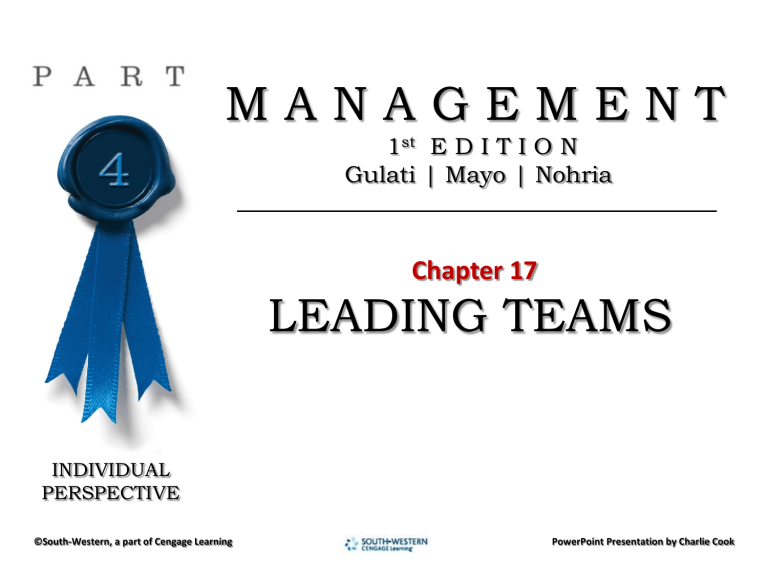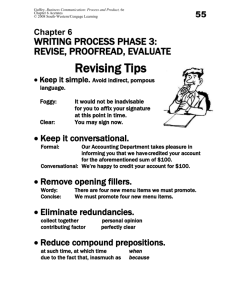Gulati_Mgmt_PPT

INDIVIDUAL
PERSPECTIVE
©South-Western, a part of Cengage Learning
M A N A G E M E N T
1 st E D I T I O N
Gulati | Mayo | Nohria
Chapter 17
LEADING TEAMS
PowerPoint Presentation by Charlie Cook
Learning Objectives
• Distinguish between a team and a work group and outline the key elements that are essential for the establishment of a team
• Describe the dimensions and characteristics of teams and how diversity can help or hinder team performance
• Outline the stages of team development and the way in which norms are established in teams
© South-Western, a part of Cengage Learning 17 –2
Learning Objectives
• Describe how teams function and how members of the team interact to accomplish the team’s goals and objectives
• Define the major aspects of team effectiveness and explain the role that leaders play in influencing team performance
© South-Western, a part of Cengage Learning 17 –3
What Is a Team?
• A group of two or more people with complementary skills who are committed to working together to achieve a specific objective
– Has clear boundaries that define who is and is not part of the team
– Possesses the authority to manage their own work processes
– Possesses a sense of stability that enables members to work together over a set period of time
© South-Western, a part of Cengage Learning 17 –4
Teams versus Individual Work Groups
Task complexity
The amount of information that must be processed to understand the task, the degree of uncertainty about possible outcomes, the presence of many subtasks that require a range of skills and knowledge, or the absence of standardized procedures to conduct the task
Task interdependence
Extent to which group members need to work with and rely on each other to produce the collective work of the group
Task objectives
Issues that orient team members toward their goals and priorities and help them understand how their work fits in the bigger picture.
© South-Western, a part of Cengage Learning 17 –5
Team Characteristics
Team Composition and Size
Team
Environment
Collocated and
Geographically
Distributed Teams
Manager-Led versus
Self-Directed Teams
© South-Western, a part of Cengage Learning
Leveraging
Diversity
17 –6
Manager-Led versus Self-Directed Teams
Manager-led teams
The manager acts as the team leader
Vertical teams
Composed of a manager and his or her subordinates in the formal chain of command, in one functional department
Horizontal teams
Composed of employees from about the same hierarchical level but from several different departments in the organization
Self-directed teams
Determine their own objectives and the methods by which to achieve them
© South-Western, a part of Cengage Learning 17 –7
Collocated and Geographically Distributed Teams
Collocated teams
Teams that use a significant amount of face-to-face communication to make operating decisions. They operate in close proximity to one another, engage in a lot of social interaction, and provide quick feedback on the team’s progress to one another
Geographically distributed teams
Teams that are made up of geographically or organizationally dispersed members who rely heavily on electronic tools such as e-mail, fax, voicemail, telephone, and videoconferencing to interact with one another
© South-Western, a part of Cengage Learning 17 –8
Forming stage
Stages of Team Development
Occurs when team members define the task that is to be done and how that task is to be accomplished, setting the ground rules for the team
Storming stage
Occurs when team members experience conflicts about interpersonal issues and differences in perspectives
Norming stage
Occurs when team members uncover ways to create new standards that encourage more collaborative behavior
Performing stage
Occurs when team members adopt and play roles that enhance the activities of the group
Adjourning stage
Occurs when a team has completed its task and the team is disbanded
© South-Western, a part of Cengage Learning 17 –9
Components of Team Process
Purposeful and rigorous decision making
Effective participation and meaningful influence
© South-Western, a part of Cengage Learning
Effective team performance
Constructive conflict
17 –10
Figure 17.3 Team Decision-Making Process
© South-Western, a part of Cengage Learning 17 –11
Social loafing
Effective Participation and
Meaningful Influence
Disengaging from the team process and failing to contribute to the team’s recommendations or other deliverables
Participation
The extent to which individuals engage in the process of generating solutions and articulating their opinions and perspectives
Blocking behaviors
Behaviors that inhibit the team and its members from achieving their objectives
Conformity
© South-Western, a part of Cengage Learning
The action of people behaving in line with a group’s expectations and beliefs
17 –12
Figure 17.6 Conditions for Team Effectiveness
Source: Adapted from J. Richard Hackman, Leading Teams: Setting the Stage for Great Performances (Boston, MA: HBS
Press, 2002).
© South-Western, a part of Cengage Learning 17 –13
Table 17.2 Behaviors of Effective Team Leaders
© South-Western, a part of Cengage Learning 17 –14
Figure 17.7 Different Approaches to Boundary Management
Source: Adapted from Deborah Ancona, “Outward Bound: Strategies for Team Survival in an Organization,” Academy
of Management Journal, Vol. 33, No. 2, 1990, pp. 334–365.
© South-Western, a part of Cengage Learning 17 –15
Approaches for Leading Geographically
Distributed or Virtual Teams
• Manage a collocated team first
• Set guidelines for team communication
• Communicate more to avoid jargon
• Share background information
• Find highly-placed allies to sponsor team
• Watch for conflict and learn to manage it
• Debrief to better next time
© South-Western, a part of Cengage Learning 17 –16
KEY TERMS
Adjourning stage
Blocking behaviors
Boundary manager
Collocated teams
Conformity
Forming stage
Geographically distributed teams
Horizontal teams
Manager-led teams
Norming stage
Participation
Performing stage
Project teams
Self-directed teams
Social loafing
Storming stage
Task complexity
Task interdependence
Task objectives
Team
Team norms
Vertical teams
© South-Western, a part of Cengage Learning 17 –17






